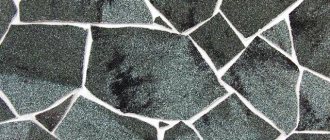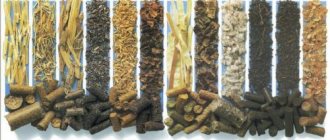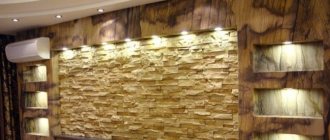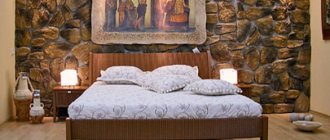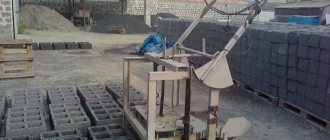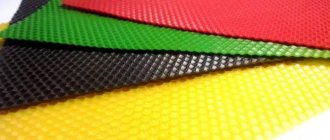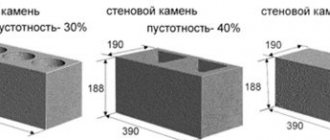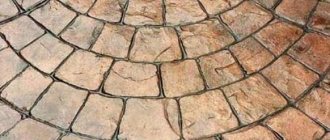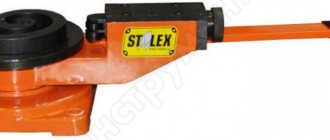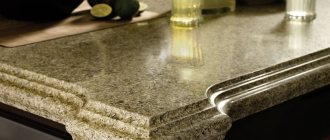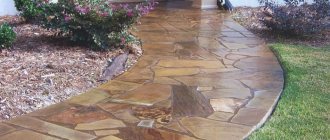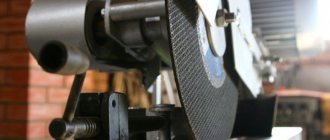Author of the article: Sudakov A.P.
Flexible stone is distinguished by naturalness and sophistication. Its popularity is due to its ease of installation and functionality. Despite the active use of building materials, the domestic production niche is not covered. A launched production line can bring its owner considerable income with minimal investment, since the cost of production is high and far exceeds cost indicators. Minimal competition will allow you to recoup production costs in the shortest possible time.
Interior finishing with flexible stone
Properties and scope of application
The scope of application of flexible stone is determined by its characteristics. It is durable, resistant to aggressive environments and has a beautiful texture, which allows it to be used for insulation and finishing of facades, as well as indoors for the installation of partitions and decorative treatment of walls, stairs, doors and fireplaces. The plasticity and light weight of the material attracts craftsmen, since with its parameters it is possible to veneer structures of any size and shape. It has found successful application in landscape design for decorating fences, fountains, creating panels and laying paths.
The main characteristics of the building and decorative material are water resistance, environmental friendliness, antistatic and fire safety. It is vapor permeable, flexible and plastic. The material contains no impurities of harmful substances, it is easy to cut and can withstand sudden temperature changes.
Among the disadvantages of flexible stone, one can note its high cost. The textured abrasive surface and the limitation in alkaline types of detergents for its treatment significantly narrow the scope of application of the material due to the need for special care.
Basic technologies
Finishing the shower room
The production of flexible stone can be organized in terms of standard or original technologies. Their implementation does not require special knowledge and skills, since all employee actions are carried out according to a regulated scenario, from which one should not deviate in order to obtain a quality product.
Standard technology
When producing flexible stone in a workshop, the entrepreneur must purchase equipment in advance to connect it to the production line. To ensure production you will need:
- sand seeder;
- drill;
- drying cabinets;
- device for cutting the finished product.
The raw material for the building material is marble chips or sand. Depending on the planned final color of the product, it can be used without special processing or subject to dyeing. Production requires inclusions of a certain diameter, so the raw material must be sifted. After preparing the base, by gluing the fiberglass, mineral raw materials are applied to it. After drying, the finished product is cut into tiles of the desired shape and size.
Small production is characterized by high profitability indicators, since the cost of the finished product is several times lower than in the construction market.
Original technology
The production of flexible stone as a business, organized using original technology in areas of sandstone deposits, is labor-intensive and expensive. However, the finished product can be sold at a much higher price, since it is distinguished by its originality due to the unique texture formed due to the unique cut pattern of sandstone, which is the raw material. The cost of the production method is due to the high cost of equipment, without which it is impossible to polish the base.
To produce the material, you need to select a section of sandstone as a base and polish it. A polymer binder composition is applied to the treated layer. The resulting base is covered with textiles, one type of which is fiberglass. After a certain time, corresponding to the hardening of the adhesive base, the fabric is removed with the imprint of the sand layer and dried.
Marketing and sales
Here are several groups of buyers interested in finishing materials:
- construction companies and finishing teams;
- construction stores and wholesale and retail chains;
- wholesale intermediaries.
The best option is to find a wholesale buyer and sell him large volumes of flexible bricks.
The level of competition in the market is assessed as average and below average. This creates additional opportunities, but still does not free the businessman from the need to make additional efforts to promote the product.
Here are some advertising methods:
- actively promote the stone via the Internet, create a website, sell goods online;
- publish advertisements in the media and in thematic publications;
- Post advertisements in entrances and cottage communities;
- Conduct email campaigns to potential clients.
Do-it-yourself flexible stone production technology
To produce flexible stone, bulk material, which is the main raw material, must be mixed with pigments. The use and combination of special additives will ensure the effect of natural stones.
Flexible stone
Fiberglass fabric, before placing sand on it, should be fired in order to remove the paraffin deposits that form during its production. Neglecting this stage of the technological process may result in poor adhesion of particles to it.
After placing the fiberglass on the template, it must be treated with an adhesive composition in a layer of 2-3 millimeters. The prepared raw material is distributed evenly over its entire surface. To obtain creative results, you can make designs from bulk material due to the special distribution of its color range.
The material with applied sand must be fixed to the template using nails or buttons and compacted with a rubber roller. Drying time depends on the polymer used to hold the sand on the fabric. To ensure plasticity of the flexible stone, you should use a hairdryer when drying it.
When it is treated with a hot air stream during the manufacturing process, it will bend better. After removing the material from the template, the particles not impregnated with the adhesive composition disappear, and the finished product can be used for its intended purpose or sold.
Liquid Stone Business Plan Marketing Plan
Attracting the attention of the target audience is the main task for an entrepreneur who decides to organize a construction business. The business plan provides for the following marketing activities aimed at promoting flexible stone:
- Creation of a website and groups on social networks;
- Distribution of commercial offers to company owners;
- Participation in construction exhibitions and fairs;
- Advertising on radio and television, in specialized newspapers and magazines;
- Participation in the decoration of a building significant for the city.
These marketing activities are aimed at attracting both individuals and legal entities.
All this should be reflected in the marketing plan of the business plan. A ready-made flexible stone business plan is available for download from the link below. It contains all the information necessary for launch, a financial model is drawn up, and calculations are made. You will begin to implement your idea without going through the planning stage. With the help of such a business plan, you will be able to attract additional financing from banks and investors.
Decorative stone made of gypsum is another type of finishing material. Market analysis shows that this area can also be in great demand. A business plan for the production of decorative stone from gypsum will allow you to foresee all the risks and compare these two options.
If you need to obtain products with a relief surface
A flexible stone with a relief surface is made on glass, which must be treated with wax and wrapped in polyethylene.
To obtain specific invoices, it is necessary to use special forms. The raw material composition must include crushed and sifted granite or marble fractions. It is possible to use quartz sand or its mixture with other components.
After mixing the ingredients with a polymer acrylic dispersion or polyester resin, the composition is applied to the glass and compacted with a roller. Drying is carried out naturally for 24 hours. The finished product is removed from the mold and cut to the desired size and shape.
The material manufacturing technology can also be used in the production of flexible stone with a flat surface. The finished product is fragile, so you need to handle it carefully. To add strength, it is recommended to apply sealants to the glass or mold before pouring the mixture, which can be fiberglass, gauze or mesh for plaster.
Manufacturing method based on plastisol
The technology for manufacturing flexible stone based on plastisol is somewhat different from the basic technique. The base is not special textiles, but glass, onto which an adhesive is applied, with a thickness not exceeding 3 millimeters. A fine-mesh mesh for plaster is placed on its surface, and bulk material is distributed on top and rolled out with a roller.
Original flexible stone production technology
Crushed brick or a mixture of sand, cement and coloring pigments can be used as raw materials, which will make it possible to make interesting products. Drying is carried out in a preheated electric oven for 15 minutes, after which the product must be cooled and removed from the glass. Before packing the flexible stone, any non-glued inclusions should be removed from its surface.
Documentation
An individual entrepreneur is the best option for registering a business for the production of building materials: registration is simplified, there is little reporting and there are no problems with choosing premises. The tax system can be chosen as standard at a rate of 6% of profit. However, in the future, for the successful sale of flexible stone, quality certificates will be required. List of papers for business registration:
- Application for state registration of individuals. persons as individual entrepreneurs (form No. P21001).
- Copy of ID.
- A document confirming payment of the state duty.
The above documents are easy to collect and only take a couple of days.
Manufacturing of thermal panels
Thermal panels are used for insulation and finishing of facades. They consist of polyurethane foam and a facing part in the form of flexible stone, marble chips or clinker tiles. To produce thermal panels, special molds are required. In order for the finished product to be removed from them without any problems, you must first apply a special lubricant to their surface, and then lay out the facing element, which is a flexible stone, in its cells. The ribs of the mold between the tiles are sprinkled with sand, and its cavity is filled with liquid polyurethane foam using pouring equipment. After closing the mold, you must wait until the thermal panel has completely dried, after which it must be removed and used for its intended purpose or packaged.
Premises requirements
A number of requirements are put forward for the premises in which the production of façade thermal panels and flexible stone is planned:
- area – from 30 m²;
- temperature – from 15ºС to 25ºС;
- lighting level – general;
- Exhaust ventilation and sewage drainage are desirable.
The room must be divided into zones:
- room for preparing mortar for flexible stone;
- a place to install a machine for applying the solution;
- area for working with sand and marble chips;
- drying room;
- warehouse for storing finished products.
Production conditions
Equipment for the production of flexible stone should be placed in a well-ventilated and lighted area with a level base.
For normal maintenance of the technological process, its area should not be less than 100 square meters. To mix the components you will need a clean container and a drill with an attachment, and to glue them together you will need an adhesive. Polymer plasticizers and acrylic-based adhesive impregnations were tested.
Relief flexible stone
The composition is applied to a fabric base. Fiberglass is most often used because it is characterized by such universal qualities as plasticity, resistance to aggressive environments and tensile strength. Molding is done using templates, which you can make yourself from thick plywood or from OSB board, along the perimeter of which a limit strip is nailed.
The main raw material is quartz sand or crushed marble. Marble chips must be sifted to give the fraction a visually uniform size. To provide a variety of colors, dyes will be needed. Metal oxides are used as pigments.
Which taxation system to choose for the production of thermal panels
Among several systems by which it will be necessary to pay tax, we focus on the simplified one, it is available for limited liability companies. This tax system provides a choice of two tax payment options:
- You can pay a tax of 15% on the net profit received. But here it will be necessary to provide relevant documents that confirm the expenses incurred by the company in the manufacture of products.
- income tax of 6%. In this case, you do not need to provide any supporting documents about expenses.
Financial plan
When drawing up a business plan for a project, you should include it in a section that displays the costs of organizing it. It is necessary to plan 800,000 rubles for the purchase of equipment, and about 150,000 rubles will be spent on renting and preparing the premises for production. Obtaining permits will cost around 6,000 rubles. As a result, start-up costs will cost the entrepreneur 956,000 rubles.
When calculating the cost per square meter of a product, the costs of its production are taken into account. The main cost item will be the cost of raw materials, corresponding to 150 rubles. The labor costs of hired workers correspond to 50 rubles, and 5 rubles will be spent on electricity. Taking into account additional expenses of 5 rubles, the cost will correspond to 210 rubles. When manufacturing a thermal panel, the production costs are similar. The only difference is the cost of raw materials, corresponding to 230 rubles. As a result, their final cost corresponds to 290 rubles.
The amount of profit can be calculated based on the parameters of the cost and market value of the product. The price of flexible stone corresponds to 900-1300 rubles, and thermal panels - 1200-1800 rubles per square meter.
By producing and selling 50 square meters of each product category, you can earn 690X50+910X50=80,000 rubles. By increasing the product range, you can earn up to 700,000 rubles per month.
How to advertise a business
Flexible stone is not an essential item, so your advertising should clearly hit the target audience: finishing teams, designers, individuals involved in repairs.
Create a website with high-quality photographs of your products and a detailed description of their advantages, place advertisements on Avito and websites about repairs and construction, and agree on cooperation with the finishing team.
As production volumes increase, increase your distribution channels. Enter into agreements with construction stores, offering them your products.
And if things go very well, then you can open your own flexible stone store, which will significantly reduce the costs of intermediaries.
